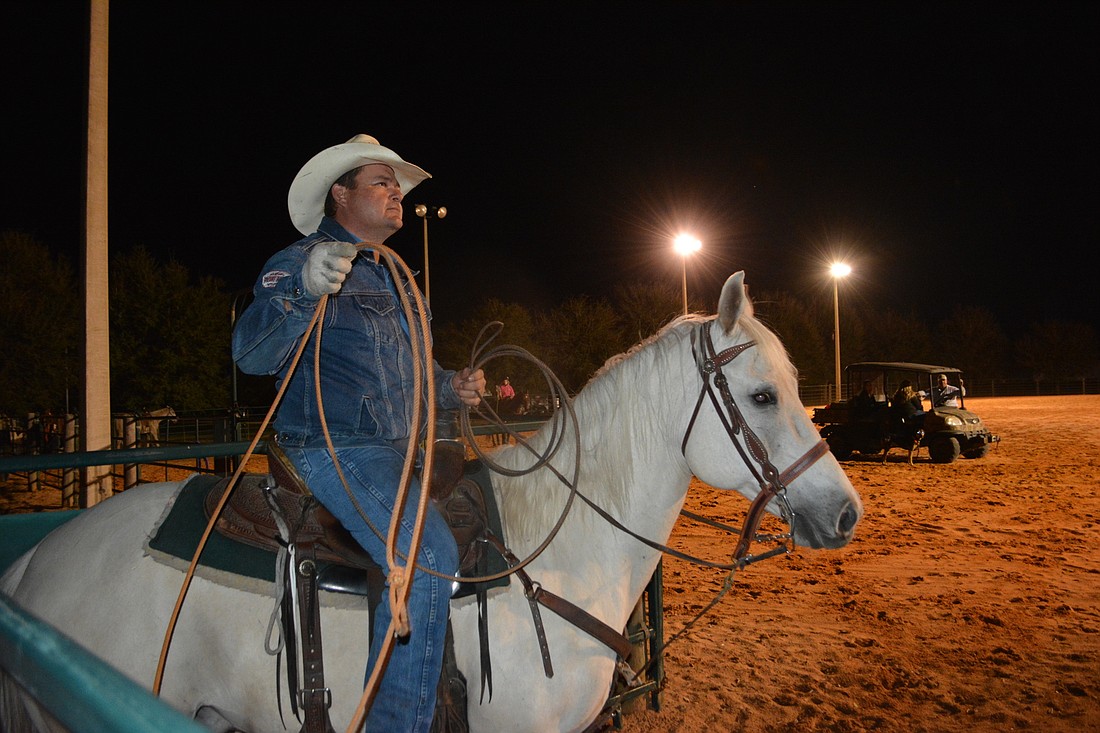- April 24, 2024
-
-
Loading

Loading

Brian Jones, the president of the Manatee County Cattlemen's Association, concerns himself with growing his group's membership.
Then he drives through places like Lakewood Ranch, where the construction sprawl continues to move eastward, gobbling up acres of land once reserved for cattle or farming.
"You see the bulldozers and the dump trucks," Jones said with a sigh.
For Jones, the foreman of Arcadia's Longino Ranch, being a cowboy is a proud way of life. Sometimes he wonders if people understand what he and his peers accomplish on a daily basis in a modern world.
On Feb. 10, Jones and a group of cowboys were gathered at Steve Freeley's ranch in Lakewood Ranch. While they were practicing rodeo skills, the main emphasis on the evening was getting some of Freeley's calves ready for the ninth annual Manatee County Ranch Rodeo that will be held Feb. 18 at the Manatee County Fairgrounds.
While the rodeo doesn't feature bull riding and bronc busting, it showcases many of the skills critical to running a ranch. The event is sponsored by the Manatee County Cattlemen's Association, which has a mission statement to preserve and protect the beef industry along with the cowboy's way of life.
"This is our livelihood," said Jones, who is the rodeo's chairman.
If you want to see what a working cowboy does, the Ranch Rodeo is a great opportunity to do so. It's $5 for a ticket, and children 10 and under get in free. The event, which begins at noon and features 13 teams and 65 cowboys, has a "boot race" for children, who run to grab a boot that is filled with a prize. The children also get to chase calves around the arena until one of them can grab the ribbon off a tail.
Of course, the team competition is the highlight and teams of five cowboys (actually four cowboys and one cowgirl) compete for championship belt buckles and the coveted Walter Mann Top Hand Award that goes to the top overall cowboy. The award is judged and presented by Mann's widow, Myakka City's Faye Mann.
The team competition includes team sorting, team doctoring, calf branding, woods tying and double mugging. The rodeo, which awards more than $2,500 in cash prizes, is a qualifier for the Florida Cattlemen's Association State Ranch Rodeo Finals Sept. 29-30 at the Silver Spurs Arena in Kissimmee.
Although rodeo fans won't see anyone trying to ride a bull, Jones said the Ranch Rodeo is really a "young man's sport."
"This is fun to watch," he said. "And it's a sport where you can get hurt. You won't be seeing Joe Schmo off the street."
In case you aren't familiar with the timed events, here is a brief breakdown.
Team sorting involves 15 calves, all with different numbers, and the cowboys are given three to cut out from the others. But there is a caveat. If any of the calves not being sorted get spooked and leave the designated area where they all start, the team is eliminated. So the five-person team must move around the calves very quietly and efficiently. Not only do the cowboys need to know how to read the calves, but their horses do, too.
In calf branding, the four cowboys on the team rope the calf and get it down while the cowgirl marks it with chalk. The cowgirl can't run to the calf until it is on the ground, so the cowboys don't want the calf running to the other side of the arena.
The double mugging involves roping a 800-pound yearling, getting it down and tying off its legs so it can't move for six seconds. Obviously, the cowboys can get stomped in this one.
Team doctoring is an event that mimics what cowboys have to do on the range when they need to take a close look at an animal. They have to rope both the head and the back legs, then lay the animal broadside. The cowgirl marks different areas on the animal as if she was doing an inspection. Jones said the crowd really gets fired up when the cowboys quickly rope both back heels.
Wood tying involves roping and then tying a calf to a post. When you working in open land, cowboys often had to tie a stray to a tree.
When all the events are done, Jones said the crowd will appreciate one fact. "They will see how passionate we are about our job," he said.
Lunch will be served by the Junior Cattlemen so Jones says to come hungry. Proceeds from the event fund the Junior Cattlemen's participation in local, state and national events and also go to local Future Farmers of America chapters and 4-H clubs. For more information, call Cassidy Jones at 352-745-1440 or email her at [email protected].